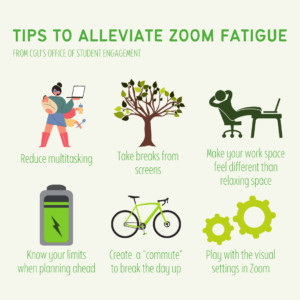Alleviating “Zoom Fatigue” in Graduate School

As we see the end of the academic year quickly approaching, it can be difficult to keep the momentum going. Finishing the semester as strong as you started is easier said than done, and one of the best ways to do so it to avoid burnout.
With over a year of virtual school, work, and social interactions, some of us may feel like pros when it comes to managing screen time and its effects on mental health. Even if you feel like you have it down to a science, checking in with yourself and reevaluating your habits and routines is never a bad idea!
Something we have likely all faced in the past year is Zoom Fatigue. Symptoms of Zoom Fatigue include feeling exhausted, irritated, and defeated after logging off of a virtual meeting. This article from Stanford News shows early research that the burnout we feel after videoconferencing is attributed to excessive amounts of eye contact, seeing ourselves on screen, decreased mobility, and a higher cognitive load.
While keeping your boundaries and limits in mind, it is also important to continue to make time for friends, colleagues, and still engage in virtual spaces mindfully. Our previous blog post dives into the importance of community building as a graduate scholar. To minimize burnout, it is encouraged that you lean on your various communities and stay involved with CGU as much as possible. Keep reading to learn our tips for minimizing Zoom Fatigue as a graduate student.
Try your best to not multitask. As tempting as it is to check the new email you received or to complete a reading for another class during a Zoom meeting, try to stay focused on just one thing: the speaker. When we multitask, we are switching between tasks at a quicker rate, causing our brains to constantly move to our next thought. This quick switching can cause more exhaustion in the long run. Setting aside blocks of time in your daily schedule to focus on a certain task can help narrow your focus and prevent some of the post-Zoom exhaustion.
Take screen breaks. We cannot stress how important this is! Take just a few minutes to step outside for some fresh air or complete some stretches at your desk. Head to the kitchen to replenish your snacks, water, and coffee often. If you have a pet, take a moment to cuddle up to them! We need to take breaks throughout the day, and this will likely optimize your productivity.
Many of us are likely not making a commute to work or school, one way to make the day seem a little more normal is to schedule “commute time” into your day. Taking extra time in the morning and afternoon to meditate, enjoy a hearty meal, or to walk or ride a bike allows us to have some transitional time throughout the day. This can help us differentiate between the work/school day and our personal time, which we will cover more later in this post.
Keep your limits in mind when signing up for classes and planning your time. Being aware of limits and boundaries can be difficult for many, and this skill often comes with time. Remind yourself that you do no have to do it all. Remember, you will need time for your own personal commitments throughout the week. Free time doesn’t always have to be the same as your availability! When planning for your semester, keep your future self in mind and try not to take on too much at once. Maybe take a summer course to alleviate some pressure in the fall.
Have your “work” or “study” space feel different than your relaxing space. While many of us do not have a dedicated office room, it is still possible to create a different feel for the space you are working or studying in. Small changes to your work and school routine can help your brain differentiate between when it is time to focus or relax. You can create a different ambiance in your space during your “focus time” by only drinking your coffee from a certain mug, listening to a different playlist, or diffusing certain essential oils while you want to be productive. You can even try to play with your lighting situation based on the time of day. If you are in class or studying and need to concentrate, maybe turn on extra lights to brighten the room and keep you engaged. When it is time to wind down after a long day, give the bright lights a break and opt for a small lamp or string of lights to illuminate your space.
Play with the visuals of Zoom. As we mentioned in the beginning of this post, it can be exhausting to stare at your own face for hours on end while videoconferencing. Utilizing the settings to hide self-view can give yourself a break from looking at your reflection. Try switching to “speaker view” to focus on the person speaking or minimize your videoconferencing window to exert yourself less. These small steps can drastically improve your energy levels after class or work meetings.

We hope you take some of this advice and implement it into your daily routines. It is important to check in with yourself often. What you need one day may differ from the next! What helps minimize your Zoom Fatigue symptoms? How do you create your space at home to feel different than the space you relax in? We want to hear from you! If you have any questions, comments, or suggestions for upcoming blog posts, we invite you to email us at student.engagement@cgu.edu.
Share